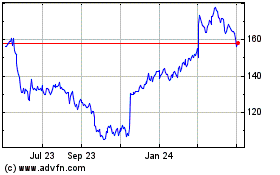Target's Margins Shrink as Traffic In Stores Falls, Digital Sales Leap -- WSJ
April 24 2020 - 3:02AM
Dow Jones News
By Sarah Nassauer
This article is being republished as part of our daily
reproduction of WSJ.com articles that also appeared in the U.S.
print edition of The Wall Street Journal (April 24, 2020).
Target Corp. said sales from stores weakened significantly in
late March and early April, while online sales surged, squeezing
profits as shoppers grew increasingly reluctant to venture outside
amid the coronavirus pandemic.
Consumers flocked to stores to stock up in late February and
early March, but traffic slowed considerably and buying shifted
online through home delivery, store pickup and other services, said
Target Chief Executive Brian Cornell on a call with reporters.
"As expected, as millions sheltered in place, sales trends in
stores started to soften," said Mr. Cornell. "The consumer is
listening to direction."
Since Feb. 1 Target's comparable sales, those from stores and
digital channels operating for at least 12 months, rose 7%. In the
first three weeks of March, comparable sales rose 20%, the company
said last month. So far in April comparable sales are up more than
5%, the company said. Digital comparable sales have risen more than
275% during that period.
Throughout, Target has experienced a surge in sales of food,
household goods and, more recently, office supplies and cooking
appliances, while sales of higher-margin goods such as apparel and
accessories have fallen. That dynamic, along with higher labor
costs and the shift to digital sales, which are less profitable
than store sales, are eating into margins, the company said.
Those factors, as well as write-downs associated with reducing
its inventories of apparel and accessories, will lower the
company's first-quarter operating margin by more than 5 percentage
points, the company said.
Target shares were down about 4% to $102.63 in early trading
Thursday.
Last month Target withdrew its financial forecast for the
quarter and full year and said it would suspend share repurchases.
At the time, Target said it expected to spend an additional $300
million during the current quarter on virus-related changes to
labor, cleaning routines and supply-chain demands.
Some trends, especially the shift toward digital fulfillment,
are likely to be long-lasting, Mr. Cornell said on the call.
Longer-term, shoppers will "embrace routines developed during these
weeks at home with their families," he said. Target's model of
using stores as online delivery and pickup hubs "will continue to
serve us well," he said. "Today, it's proving critical."
Many retailers deemed nonessential by local governments have
closed and furloughed workers. For the others, staying open has
brought its own set of challenges.
Tractor Supply Co. said earlier this month that comparable sales
grew 12% in March, with consumable goods such as animal feed and
heating fuel up more than 20%, offsetting declines in other
categories such as clothing and footwear.
Walmart Inc., the country's largest retailer by revenue, has
about 150,000 of its 1.5 million U.S. workers out on leave due to
coronavirus-related issues, The Wall Street Journal reported last
week.
Other sectors have seen parts of their business grow and other
parts hurt by the broader impact of the pandemic. For example,
Facebook Inc., Twitter Inc. and several news websites have reported
rising use of their products but also warned about the sharp
pullback in advertising.
Target said it would extend the added benefits and pay it
offered hourly workers starting last month. Target will now
temporarily pay workers at least $15 an hour through the end of
May, as well as extend backup child-care benefits and a 30-day paid
leave for workers who are 65 and older, pregnant or have underlying
medical conditions.
Write to Sarah Nassauer at sarah.nassauer@wsj.com
(END) Dow Jones Newswires
April 24, 2020 02:47 ET (06:47 GMT)
Copyright (c) 2020 Dow Jones & Company, Inc.
Target (NYSE:TGT)
Historical Stock Chart
From Aug 2024 to Sep 2024

Target (NYSE:TGT)
Historical Stock Chart
From Sep 2023 to Sep 2024
